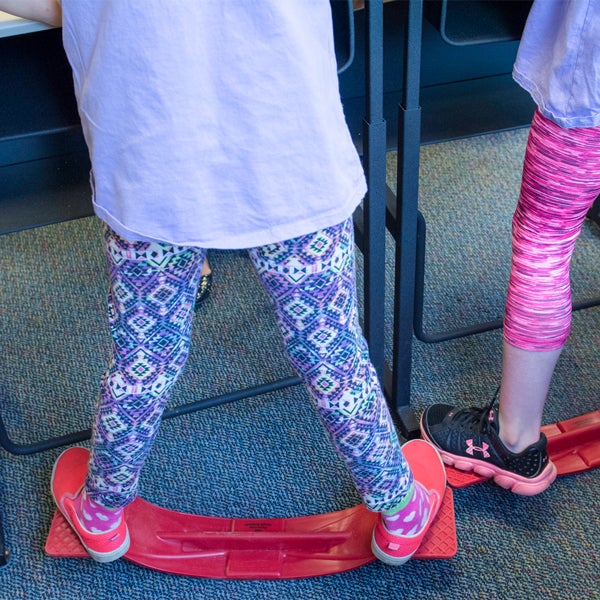The second-graders at West Kingston Elementary School are models of scholarly focus, reading silently and intently. Meanwhile, they wobble in their seats, pedal their legs under their desks or sway on balance boards.
This is exactly what they should be doing in their kinesthetic classrooms, where University of Rhode Island researchers studied the effects of movement on learning and language over four weeks in May.
“It’s everything we got in trouble for when we were kids,” Emily Clapham, associate professor of kinesiology, said of the jiggling legs and widespread wiggling.
She and fellow researcher Michelle Flippin, assistant professor of communicative disorders, outfitted the classrooms with standing desks, bouncy foot rests, exercise balls, pedal desks, balance boards and learning stools — all of which allows kids to move while they learn.
Communicative disorders and kinesiology graduate students collect data based on classroom observations of whether the children are on or off task at a given time. This final measurement serves as snapshot for academic achievement, Flippin explained.
Kinesthetic classrooms are not new, but the URI project breaks new ground by measuring language patterns and usage in the context of movement. No other school is studying a kinesthetic classroom in a controlled manner, and no other school is looking at connections between movement, language and being on task, the researchers said.
The unique language analysis piece uses LENA digital language-sampling processors and software. The children wear recorders two days a week, and the technology digitally records hours of audio and performs sophisticated analyses of each child’s language.
“We will have a wealth of data, so we will have a good idea of whether this is improving student focus as well as which piece of equipment works best for each individual student,” Flippin said.
The community at West Kingston Elementary School didn’t need to see the data to offer endorsements. “Oh my gosh, I love it,” said teacher Caighln Perrin. “We have a very rigorous curriculum, so for them to be able to move and make their own choices is super. They are ready to work, willing to work and motivated.”
The children will quickly tell you which piece of furniture they like best. “My favorite is the standing desk. When you move, it exercises you and it helps you focus,” one girl offered.
“If you get tired of sitting down, you can stand up and get a little stretch,” one boy added.
“It never used to be like this,” Perrin said, looking around the quiet room of attentive readers.

